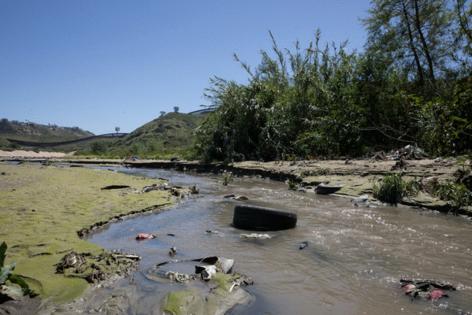Pollution from the Tijuana River is ending up in the air near the border, study finds
Published in News & Features
Researchers have found that pollutants in the Tijuana River, which carries raw sewage and industrial waste from Tijuana, are also turning up in the air along the coast near the U.S.-Mexico border.
After collecting samples from air and water along the coast, scientists from the University of California, San Diego determined that fine particles of various pollutants from wastewater are in the air in parts of San Diego County. They found that sea spray aerosols contain illicit drugs and drug byproducts that occur in human urine, as well as chemicals from tires and personal care products.
The researchers said the pollutants are carried in wastewater and stormwater runoff, and become airborne in spray where the river meets the crashing waves near the border, and also likely enter the air from churning waters in the river itself.
The findings show that the river, in addition to carrying water pollution that has forced beach closures and odors that have plagued nearby communities, also is releasing fine particles of air pollution beyond what people can see or smell. The researchers said, however, that the potential health effects of breathing these pollutants aren’t yet known.
“Often the sewage crisis is considered a water issue — and it is — but we show that it’s in the air too,” said Jonathan Slade, a co-author and associate professor of chemistry at UC San Diego. “This study points to it being an air quality issue, which requires more focus and more study in the future to understand the effects of exposure to these chemicals.”
The study, published Wednesday in the journal Science Advances, involved testing air and airwater samples collected in 2020 at locations including the U.S.-Mexico border, Imperial Beach and the Scripps Institution of Oceanography in La Jolla.
The researchers used a compound called benzoylecgonine, a byproduct of cocaine use found in urine, to trace the pollutants to wastewater. They also tested for cocaine and about a dozen chemicals found in wastewater and urban runoff, including methamphetamine, octinoxate from sunscreen and dibenzylamine from tires.
They found concentrations were significantly higher in the air near the river mouth at the border and Imperial Beach than farther north along the coast at the Scripps Pier in La Jolla.
“Some of these compounds, we measured concentrations that are as high as what a worker would be exposed to at a wastewater treatment plant if they’re standing directly over an aeration tank,” Slade said, “where it’s often recommended that you wear personal protective equipment like masks.”
The research team, which included scientists from UC San Diego and Scripps Institution of Oceanography, wore respirators and protective gear while collecting samples near the Tijuana River.
“We see some of this stuff coming out at levels that can be concerning,” Slade said. “But we don’t know the effects of chronic exposure, long-term exposures of people living in the South Bay region, breathing in this air on a daily basis for years or decades.”
Adam Cooper, the lead author, said the research is “one of the most comprehensive studies to date investigating water-to-air transfer of these pollutants.”
Other research is underway examining other types of air pollution from the Tijuana River, including bacteria and other pathogens from sewage.
Kimberly Prather, a UC San Diego professor of atmospheric chemistry, has been researching air pollution from the river for years.
“This is the No. 1 way that this pollution from the water is actually making its way into your body, even if you’re not at the beach,” Prather said. “The beaches can be closed, but people are still breathing that air.”
©2025 Los Angeles Times. Visit at latimes.com. Distributed by Tribune Content Agency, LLC.







Comments